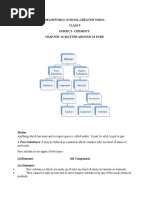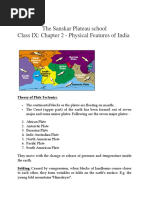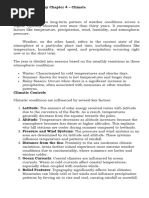Climate Class 9 Notes
Climate Class 9 Notes
Uploaded by
bhumikadhariwal3Copyright:
Available Formats
Climate Class 9 Notes
Climate Class 9 Notes
Uploaded by
bhumikadhariwal3Original Title
Copyright
Available Formats
Share this document
Did you find this document useful?
Is this content inappropriate?
Copyright:
Available Formats
Climate Class 9 Notes
Climate Class 9 Notes
Uploaded by
bhumikadhariwal3Copyright:
Available Formats
Climate refers to the sum total of weather conditions and variations over a large
area for a long period of time (more than thirty years).
Weather refers to the state of the atmosphere over an area at any point in time.
The elements of weather and climate are the same, i.e. temperature, atmospheric
pressure, wind, humidity and precipitation. On the basis of the monthly
atmospheric conditions, the year is divided into seasons such as:
Winter
Summer
Rainy Seasons
Climatic Controls
The climate of any place depends on the following factors:
1) Latitude
The amount of solar energy received varies according to latitude due to
the curvature of the earth. That’s why air temperature generally decreases
from the equator towards the poles.
2) Altitude
The atmosphere becomes less dense, and temperature decreases when we
go to a higher altitude from the Earth’s surface. This is the reason why
hills are cooler during summer.
3) Pressure and wind system
The pressure and wind system of any area depend on the latitude and
altitude of the place. It influences the temperature and rainfall pattern.
4) Distance from the sea
The sea exerts a moderating influence on the climate. As the distance
from the sea increases, its moderating influence decreases and people
experience extreme weather conditions. This condition is known
as continentality, i.e. very hot during summers and very cold during
winters.
5) Ocean currents
Ocean currents, along with onshore winds, affect the climate of the coastal
areas. For example, any coastal area with warm or cold currents flowing past
it will be warmed or cooled if the winds are onshore.
6) Relief features
Relief plays a major role in determining the climate of a place. High
mountains act as barriers to cold or hot winds. They may also cause
precipitation if they are high enough and lie in the path of rain-bearing
winds. Precipitation is any form of moisture which falls to the earth. It
includes rain, snow, hail and sleet.
Factors Affecting India’s Climate
Latitude
The Tropic of Cancer passes through the middle of the country from the
Rann of Kachchh in the west to Mizoram in the east. India’s climate has
characteristics of tropical as well as subtropical climates.
Altitude
India has mountains to the north and also has a vast coastal area where
the maximum elevation is about 30 metres. Owing to the mountains, the
subcontinent experiences comparatively milder winters as compared to
central Asia.
Pressure and winds
The climate and weather conditions in India are governed by the
following atmospheric conditions:
Pressure and surface winds
Upper air circulation
Western cyclonic disturbances and tropical cyclones
Air moves from the high-pressure area over the southern Indian Ocean in
a south-easterly direction, crosses the equator and turns right towards the
low-pressure areas over the Indian subcontinent. These are known as
the Southwest Monsoon winds. These winds blow over the warm
oceans, gather moisture and bring widespread rainfall over the territories
of India.
Jet streams are fast-flowing, narrow, meandering air currents in the
atmosphere.
The Indian Monsoon
The Indian Monsoon is a crucial weather phenomenon that significantly
influences India’s climate:
1. Seasonal Reversal of Winds: Monsoon refers to the seasonal reversal of
wind direction. During summer, landmasses in India heat up more than
surrounding oceans, creating low-pressure areas over land and high-
pressure areas over the seas.
2. Inter-Tropical Convergence Zone (ITCZ): The shift of the ITCZ over
the Ganga plain during summer, known as the monsoon trough, brings
heavy rainfall to the region.
3. High-Pressure Systems: A high-pressure area east of Madagascar and
over the Indian Ocean affects the monsoon by influencing wind patterns.
4. Tibetan Plateau: Intense heating of the Tibetan Plateau creates low-
pressure systems at high altitudes, contributing to the monsoon’s strength.
5. Jet Streams: The movement of the westerly jet stream north of the
Himalayas and the tropical easterly jet stream over the Indian peninsula
during summer also play significant roles in the monsoon’s behavior.
6. Southern Oscillation (SO): Variations in pressure conditions over the
southern oceans, coupled with irregular wind and sea surface temperature
changes in the tropical eastern Pacific Ocean (known as Southern
Oscillation), affect monsoon patterns in the tropics and subtropics.
The Seasons of India
India experiences four distinct seasons throughout the year, each characterized
by unique weather patterns and agricultural significance:
1. The Cold Weather Season (Winter):
Duration: Mid-November to February.
Features: December and January are the coldest months, with
temperatures decreasing from south to north. Days are warm with cold
nights, clear skies, low humidity, and variable winds.
Significance: Critical for cultivating ‘rabi’ crops.
2. The Hot Weather Season (Summer):
Duration: March to May.
Features: Rising temperatures and falling air pressure, especially in
northern India. ‘Loo’, strong hot dry winds, are common. Pre-monsoon
showers aid in mango ripening.
Significance: Preparation for the monsoon; early mango crop ripening
due to pre-monsoon showers.
3. Advancing Monsoon (Rainy Season):
Duration: June to September.
Mechanism: Southwest monsoon winds originating from the southeast
cross the equator and enter India, covering the country over a month.
Features: Mawsynram receives the highest average rainfall globally.
Monsoon characterized by breaks and tropical depressions affecting
rainfall intensity.
Significance: Vital for agriculture; planting and growth of ‘kharif’ crops
depend on monsoon rains.
4. Retreating Monsoon (Transition Season):
Duration: October to November.
Features: Clear skies and rising temperatures mark the retreat of
monsoon. Days are hot, nights are cool and pleasant initially but become
oppressive due to high humidity (‘October heat’).
Significance: Transition from rainy season to dry winter conditions;
critical for harvesting ‘kharif’ crops and preparing for winter crops.
These seasons play a crucial role in shaping India’s agriculture, economy, and
daily life, each bringing its own set of challenges and opportunities.
Distribution of Rainfall in India
India exhibits a diverse pattern of rainfall distribution across its vast geography,
influencing its agricultural and ecological diversity:
1. High-Rainfall Regions:
Western Coast and Northeastern India: Receive over 400 cm of
rainfall annually.
Features: Lush vegetation and tropical climate supported by heavy
monsoon rains.
2. Low-Rainfall Regions:
Western Rajasthan, Gujarat, Haryana, Punjab: Receive less than 60
cm of rainfall annually.
Features: Arid and semi-arid landscapes, characterized by desert and dry
scrub vegetation.
3. Moderate-Rainfall Regions:
Interior Deccan Plateau and East of Sahyadris: Experience moderate
rainfall.
Features: Mixed vegetation, including deciduous forests and grasslands.
4. Snowfall Region:
Himalayan Region: Receives snowfall, contributing to the perennial
rivers originating from the glaciers.
Features: Alpine and sub-alpine ecosystems, crucial for riverine systems.
5. Variability:
Annual Variability: Rainfall patterns vary significantly from year to
year, impacting agriculture and water resources.
Monsoon as a Unifying Bond
The monsoon plays a pivotal role in unifying the diverse regions of India
through its seasonal rhythms:
Seasonal Alteration: Monsoon winds bring a rhythmic cycle of seasons,
affecting weather patterns across the subcontinent.
Uncertainties and Unity: Despite uncertainties in rainfall distribution,
the anticipation and arrival of monsoon rains are eagerly awaited
nationwide.
Agricultural Lifeline: Monsoons provide vital water for agriculture,
setting in motion planting and growth cycles crucial for the country’s
food security.
You might also like
- Structure of Atom (Prashant Kirad)Document6 pagesStructure of Atom (Prashant Kirad)mamtakachhi678% (9)
- French Revolution Handwritten NotesDocument8 pagesFrench Revolution Handwritten NotesPriyad Mundada86% (7)
- Matter in Our Surroundings (Prashant Kirad)Document6 pagesMatter in Our Surroundings (Prashant Kirad)Raj86% (14)
- Is Matter Around Us Pure (Prashant Kirad) - 1Document8 pagesIs Matter Around Us Pure (Prashant Kirad) - 1anshumanjain.184982% (11)
- Nazism and The Rise of Hitler Notes Class 9Document44 pagesNazism and The Rise of Hitler Notes Class 9shangchimaster2377% (22)
- History PPT SocialismDocument17 pagesHistory PPT SocialismSoundarya karthikeyan100% (5)
- Notes - Nazism & The Rise of Hitler Class 9 Notes - EduRev PDFDocument14 pagesNotes - Nazism & The Rise of Hitler Class 9 Notes - EduRev PDFvivek pareek100% (2)
- RB211 Bleed ValvDocument10 pagesRB211 Bleed Valvyasser_nasef5399100% (1)
- Electoral Politics Notes Class 9Document6 pagesElectoral Politics Notes Class 9nandita singh100% (6)
- Poverty As A Challenge - Padhle 9th Social Science NotesDocument31 pagesPoverty As A Challenge - Padhle 9th Social Science NotesPriyanshu Verma100% (5)
- CBSE Notes Class 9 Social Science Geography Chapter 3 - DrainageDocument4 pagesCBSE Notes Class 9 Social Science Geography Chapter 3 - DrainageHarish Lunge50% (4)
- Notes of CH 4 Climate - Class 9th GeographyDocument5 pagesNotes of CH 4 Climate - Class 9th GeographyBijay Ketan MiahraNo ratings yet
- Population - Class 9 Notes PadhleDocument11 pagesPopulation - Class 9 Notes PadhleArnav100% (4)
- The Story of Village Palampur - Padhle Class 9 Social ScienceDocument19 pagesThe Story of Village Palampur - Padhle Class 9 Social SciencePriyanshu VermaNo ratings yet
- CBSE G+09 Food+Security+in+India NotesDocument5 pagesCBSE G+09 Food+Security+in+India Notessumitratripathi54100% (1)
- CBSE Class 9 Political Science (Civics) Chapter 1 Notes - What Is Democracy - Why DemocracyDocument6 pagesCBSE Class 9 Political Science (Civics) Chapter 1 Notes - What Is Democracy - Why DemocracyBharat Kakarwal50% (2)
- 9th Geography Chapter 2 NotesDocument11 pages9th Geography Chapter 2 NotesSandhya Singh100% (5)
- Socialism in Europe and The Russian Revolution - Padhle Class 9 Social ScienceDocument27 pagesSocialism in Europe and The Russian Revolution - Padhle Class 9 Social ScienceJnv GurugramNo ratings yet
- Social Science Class 9 CBSE Working of Institutions NotesDocument5 pagesSocial Science Class 9 CBSE Working of Institutions Notesgurdeepsarora873870% (10)
- Class IX - Chapter 4 (Climate) Question & AnswerDocument18 pagesClass IX - Chapter 4 (Climate) Question & AnswerRajkumar Jain82% (11)
- India - Size and LocationDocument14 pagesIndia - Size and Locationanon_5010936275% (4)
- Constitutional Design - Padhle Class 9 Social Science PDFDocument20 pagesConstitutional Design - Padhle Class 9 Social Science PDFHUNTER X GAMING100% (2)
- ElectoralPolitics NotesDocument6 pagesElectoralPolitics Notesgurdeepsarora8738100% (4)
- Class 9 Social Science Notes For Session 2024-25 Chapter - 5 Pastoralists - in - The - Modern - WorldDocument31 pagesClass 9 Social Science Notes For Session 2024-25 Chapter - 5 Pastoralists - in - The - Modern - Worldkumarisudesh1560100% (1)
- Padhle 9th - French Revolution NotesDocument18 pagesPadhle 9th - French Revolution Notes45Anvay Dahiya9ANo ratings yet
- DRAINAGE CLASS 9TH GeographyDocument21 pagesDRAINAGE CLASS 9TH GeographyShipra agrawalNo ratings yet
- Fundamental Unit of Life - Class 9 Notes PadhleDocument24 pagesFundamental Unit of Life - Class 9 Notes Padhleyamew26128100% (3)
- Class 9 Geography Chapter 4 Extra Questions and Answers ClimateDocument17 pagesClass 9 Geography Chapter 4 Extra Questions and Answers ClimateDebansh Sahu100% (1)
- Working of Institutions Question BankDocument35 pagesWorking of Institutions Question BankArnav SahooNo ratings yet
- India Size and Location Class 9 NotesDocument21 pagesIndia Size and Location Class 9 NotesNaseeb Yadav100% (2)
- Improvement in Food Resources - Class 9 Notes PadhleDocument21 pagesImprovement in Food Resources - Class 9 Notes Padhleerorrz108100% (2)
- Gravitation (Prashant Kirad)Document8 pagesGravitation (Prashant Kirad)h.yfitness34100% (10)
- Work and Energy (Prashant Kirad)Document8 pagesWork and Energy (Prashant Kirad)rehana123987hhh75% (4)
- Notes of CH 3 Atoms and Molecules Class 9th ScienceDocument11 pagesNotes of CH 3 Atoms and Molecules Class 9th ScienceSingh J100% (2)
- Detailed Chapter Notes - Democratic Rights, SST, CBSE Class 9 Class 9 Notes - EduRevDocument16 pagesDetailed Chapter Notes - Democratic Rights, SST, CBSE Class 9 Class 9 Notes - EduRevvivek pareek100% (3)
- Class 9 Constitutional DesignDocument27 pagesClass 9 Constitutional Designaannoosandhu100% (1)
- Atoms and Molecules (Prashant Kirad)Document7 pagesAtoms and Molecules (Prashant Kirad)parthgarg1232100% (8)
- Sound (Prashant Kirad)Document10 pagesSound (Prashant Kirad)parvrohilla23100% (10)
- Class 9th Geography Full Chapter ExplanationDocument203 pagesClass 9th Geography Full Chapter ExplanationSandhya Dhakate100% (4)
- Notes of CH 2 Is Matter Around Us Pure Class 9th ScienceDocument15 pagesNotes of CH 2 Is Matter Around Us Pure Class 9th ScienceSingh JNo ratings yet
- Free Notes: C10: GravitationDocument6 pagesFree Notes: C10: GravitationunknownNo ratings yet
- Notes - Nazism & The Rise of Hitler Class 9 Notes - EduRevDocument15 pagesNotes - Nazism & The Rise of Hitler Class 9 Notes - EduRevvivek pareek100% (2)
- Democratic Rights - Class 9 Notes PadhleDocument13 pagesDemocratic Rights - Class 9 Notes Padhlekushpratapsinghd100% (1)
- Gravitation - Padhle 9th Science NotesDocument14 pagesGravitation - Padhle 9th Science NotesSanchay KumarNo ratings yet
- Electoral Politics Class 9 Extra Questions Civics Chapter 4Document13 pagesElectoral Politics Class 9 Extra Questions Civics Chapter 411F10 RUCHITA MAARAN100% (8)
- Food Security in India One ShotDocument14 pagesFood Security in India One Shotkashvikay100% (1)
- Socialism in Europe and The Russian RevolutionDocument17 pagesSocialism in Europe and The Russian Revolutionvaidika.soni12009No ratings yet
- Class 9th History Full Chapter ExplanationDocument289 pagesClass 9th History Full Chapter Explanationpmotu9750No ratings yet
- Work and Energy Class 9th Science NotesDocument9 pagesWork and Energy Class 9th Science Notesrachna chhabra100% (1)
- PADHLENOTES - 9 - SCIENCE - CH2-Is Matter Around Us PureDocument15 pagesPADHLENOTES - 9 - SCIENCE - CH2-Is Matter Around Us PureMehul GautamNo ratings yet
- Class 9 History Timeline of Events 1Document5 pagesClass 9 History Timeline of Events 1Study Time100% (16)
- French Revolution - Shobhit NirwanDocument13 pagesFrench Revolution - Shobhit NirwanPREETI BISHT100% (4)
- Notes CH 3 Poverty As A ChallengeDocument10 pagesNotes CH 3 Poverty As A ChallengeVarshini Pera100% (1)
- Constitutional Design Class-9th PDocument24 pagesConstitutional Design Class-9th PSudipta BhattacharyyaNo ratings yet
- CBSE Class 9 Economics Chapter 1 Notes - The Story of Village PalampurDocument5 pagesCBSE Class 9 Economics Chapter 1 Notes - The Story of Village PalampurDEEPAK KHANDELWALNo ratings yet
- Notes of Is Matter Around Us Pure - Class 9Document13 pagesNotes of Is Matter Around Us Pure - Class 9Atharva Varshney80% (5)
- Physical Features of India Chapter 2class 9Document27 pagesPhysical Features of India Chapter 2class 9poonam goswami100% (1)
- Notes of CH 5 The Fundamental Unit of Life Class 9th ScienceDocument13 pagesNotes of CH 5 The Fundamental Unit of Life Class 9th ScienceSingh J50% (2)
- Grade 9 Geography Chapter 4Document5 pagesGrade 9 Geography Chapter 4arthiarthi31419No ratings yet
- Climate NotesDocument4 pagesClimate Noteseeren41789No ratings yet
- Climate Easy and Detailed Notes For Class 9thDocument6 pagesClimate Easy and Detailed Notes For Class 9thkingX GamingNo ratings yet
- BHEL CSR FMG26A-Grp-3Document22 pagesBHEL CSR FMG26A-Grp-3Abhay BansalNo ratings yet
- Patricio, Rosana A. - THC-2 ActivityDocument11 pagesPatricio, Rosana A. - THC-2 ActivityRosana PatricioNo ratings yet
- Manual Symmetry PA220Document32 pagesManual Symmetry PA220Jose Rodriguez VasquezNo ratings yet
- ACI 318 History PDFDocument106 pagesACI 318 History PDFvrb126100% (1)
- 03 - Qa - 116 - 15 (1) (4 Files Merged) PDFDocument20 pages03 - Qa - 116 - 15 (1) (4 Files Merged) PDFsubeesh upNo ratings yet
- Circulatory System VCE BiologyDocument6 pagesCirculatory System VCE BiologyCallum KennyNo ratings yet
- ETTC Objective BitsDocument17 pagesETTC Objective BitsSATYANARAYANA BODDULANo ratings yet
- Timber ExtractionDocument10 pagesTimber ExtractionSaranya DasguptaNo ratings yet
- Bài tập bổ trợ Smart world 7 có file nghe và đáp án unit 10Document7 pagesBài tập bổ trợ Smart world 7 có file nghe và đáp án unit 101171120162.dnuNo ratings yet
- Chutes Design PDFDocument11 pagesChutes Design PDFWaris La Joi Wakatobi100% (2)
- Data Communication and Networking IDocument2 pagesData Communication and Networking Imwimabadiru774No ratings yet
- BÀ RỊA VŨNG TÀU 22-23 + keysDocument10 pagesBÀ RỊA VŨNG TÀU 22-23 + keysanhvueducatorNo ratings yet
- IB DP Biology 1.1 Introduction To Cells QuestionDocument11 pagesIB DP Biology 1.1 Introduction To Cells QuestionikaNo ratings yet
- Semaphore Kingfisher Plus ManualDocument26 pagesSemaphore Kingfisher Plus ManualaudiocircuitNo ratings yet
- Kinematicsof Particles - Rectilinear Motion: KinematicsDocument98 pagesKinematicsof Particles - Rectilinear Motion: KinematicsVinoth RajaguruNo ratings yet
- RyersonGeo Publications2016Document6 pagesRyersonGeo Publications2016Mamun Ar RashidNo ratings yet
- Jaglerod Mono-Di OksidDocument10 pagesJaglerod Mono-Di OksidLiljana DimeskaNo ratings yet
- Natural Products For Psoriasis: Crimson PublishersDocument4 pagesNatural Products For Psoriasis: Crimson PublishersAyu Ansari SaragihNo ratings yet
- Data Sheet HFE-7100DLDocument4 pagesData Sheet HFE-7100DLsshaffer_9No ratings yet
- 07 Che 249 Distillation ColumnDocument8 pages07 Che 249 Distillation Column2024568653No ratings yet
- Helios - Preisser - Katalog 2012 ENDocument274 pagesHelios - Preisser - Katalog 2012 END.T.No ratings yet
- Tritex Ii Acordc: Powered ActuatorsDocument52 pagesTritex Ii Acordc: Powered Actuatorsfeliep gonzalezNo ratings yet
- Hilti HIT-RE 500 V3 Injection Mortar Technical DatasheetDocument41 pagesHilti HIT-RE 500 V3 Injection Mortar Technical DatasheetKenneth Cabacungan100% (1)
- AKM53X-ACCNC-00: AC Synchronous Servo MotorDocument2 pagesAKM53X-ACCNC-00: AC Synchronous Servo MotorRicardo DêgeloNo ratings yet
- 4PW16741-1 B EKBT - Bufftertank - Installation Manuals - EnglishDocument6 pages4PW16741-1 B EKBT - Bufftertank - Installation Manuals - EnglishBernard GaterNo ratings yet
- Mental Ability TestDocument70 pagesMental Ability TestMohamed MeeranNo ratings yet
- Guidelines For Use of Laboratory Animals in Medical CollegesDocument19 pagesGuidelines For Use of Laboratory Animals in Medical Collegesbh14561No ratings yet
- The Potential of Pomelo (Citrus Maxima) Peels As A Fertilizer To Tomato PlantsDocument11 pagesThe Potential of Pomelo (Citrus Maxima) Peels As A Fertilizer To Tomato PlantsApril Francesca LuaNo ratings yet
- Product Overview Vinnapas Dispersions: Adhesives I Polymer Binders I EuropeDocument5 pagesProduct Overview Vinnapas Dispersions: Adhesives I Polymer Binders I EuropeSaad AzzouniNo ratings yet

























































































